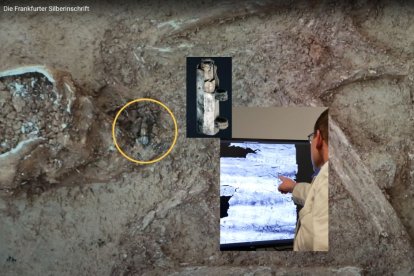The Frankfurt Archaeological Museum presents "the oldest Christian testimony north of the Alps"
The discovery of an amulet with a silver scroll in Latin of the religion's contents in a tomb brings the presence of Jesus' followers in the area forward by 50 years.

Images of the tomb, amulet and inscription.
The Frankfurt Archaeological Museum unveiled what it described as "the oldest evidence of Christian presence north of the Alps to date." It is a small silver scroll housed within a necklace pendant, containing a fully Christian Latin text. Archaeologists who discovered and studied it have dated the artifact to between 230 and 260 AD.
The amulet of protection advances the presence of the followers of Jesus north of the Alps about 50 years with respect to the oldest finds found to date. The researchers also point out that the text contained in the silver scroll is peculiar because it is written entirely in Latin - at that time it was usually Greek or Hebrew - and does not include references to other religions, neither to Judaism nor to pagan gods, something frequent at that time.
State-of-the-art technology to decipher the contents
The amulet was discovered in 2018 during excavations at a site with hundreds of Roman-era tombs in the city. It is located in an area that formed part of Nida, a Roman frontier town that was eventually abandoned. According to the museum's statement, the tomb where the silver scroll was found also contained other objects, such as an incense burner and a clay jar.
It took several weeks to decipher due to its deteriorated state. Archaeologists had to "digitally unroll" the silver sheet, which had been rolled up for about 1,800 years.
Thanks to computed tomography and art technological equipment, the text could finally be deciphered in May. Subsequently, a long period was also required for the translation process.
(Holy, holy, holy! In the name of Jesus Christ, Son of God! The Lord of the world withstands to the best of his ability all attacks(?). The God(?) grants entrance to well-being. This means of salvation(?) protects the person who submits to the will of the Lord Jesus Christ, Son of God, for all knees bow before Jesus Christ: the heavenly, the earthly and the subterranean, and every tongue confesses (Jesus Christ).
Connection with St. Paul
The reference to St. Titus, an early missionary and disciple of St. Paul the Apostle, is also unusual. The connection to St. Paul is reinforced by the last lines of the text, which are "an almost literal quotation of Paul's so-called hymn to Christ in his letter to the Philippians," according to the researchers.
According to the researchers, "The bearer of the silver amulet was clearly a devout Christian," something "absolutely extraordinary" for the time and place. However, the object's presence in Germany "does not necessarily mean that there was a large Christian community there, since such amulets are easily transportable," Gideon Bohak, of Tel Aviv University's Department of Jewish Philosophy and Talmud, told the Times Of Israel.
RECOMMENDATION





















